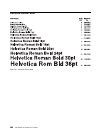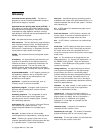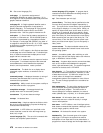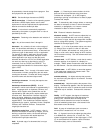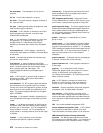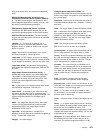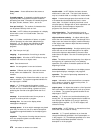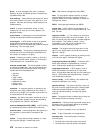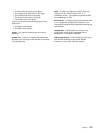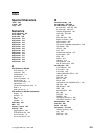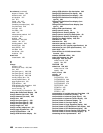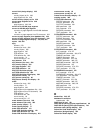library name. A user-defined word that names a
library.
licensed program. A separately orderable program,
supplied by IBM, that performs functions related to
processing user data. Examples of licensed programs
are &pcs., &cobol., &adtool., &ofcv., and so on.
lines per inch (lpi). The number of characters that
can be printed vertically within an inch.
list view. In AFP Utilities, the presentation of a display
shown while a user is in list edit mode. See also
screen view
.
logo. (1) A letter, combination of letters, or symbol
used to represent an entire word (abbreviation for
logogram). (2) The display that identifies the IBM
Corporation and the program name on licensed
programs.
lpi. See
lines per inch (lpi)
.
mapping. A representation of one thing to another.
mapping object. A function of AFP Utilities to map a
database field value to an object name.
mark. See element mark.
matrix. An arrangement in rows and columns.
member. Different sets of data, each with the same
format, within one database file. See also
source
member
.
menu. A displayed list of items from which a user can
make a selection. The system-recognized identifier for
the object type is *MENU.
merge. (1) To insert records throughout a single
output file. (2) To combine overrides for a file from the
first call level up to and including a greater call level,
producing the override to be applied when the file is
used.
message. A communication sent from a person or
program to another person or program.
message line. An area on the display where
messages are displayed.
message queue. A list on which messages are placed
when they are sent to a user ID or device description.
The system-recognized identifier for the object type is
*MSGQ.
migration. The process of moving data and source
from one computer system to another without
converting the data.
module width. In AFP Utilities, the basic element
width used in a bar code. The actual code element
may be a module width or a multiple of a module width.
object. A named storage space that consists of a set
of characteristics that describe itself and, in some
cases, data. An object is anything that exists in and
occupies space in storage and on which operations can
be performed. Some examples of objects are
programs, files, libraries, and folders.
object description. The characteristics (such as
name, type, and owner name) that describe an object.
object existence authority. An object authority that
allows the user to delete the object, free storage of the
object, save and restore the object, transfer ownership
of the object, and create an object that was named by
an authority holder.
object operational authority. An object authority that
allows the user to look at the description of an object
and use the object as determined by the user’s data
authorities to the object. See also
all authority
and
use
authority
.
offset. The distance from the beginning of an object to
the beginning of a particular field, or for substring
operations, the number of character positions from the
beginning of a field.
online information. Information on the display screen
that explains displays, messages, and programs.
operation. The result of processing statements in a
high-level language.
output. Information or data received from a computer
that is shown on a display, printed on the printer, or
stored on disk, diskette, or tape.
output queue. An object that contains a list of spooled
files to be written to an output device, such as a printer
or a diskette. The system-recognized identifier for the
object type is *OUTQ.
overlay. (1) To write over (and therefore destroy) an
existing file. (2) A program segment that is loaded into
main storage and replaces all or part of a previously
loaded program segment. (3) For AFP support, see
electronic overlay
.
overlay utility. In AFP Utilities, an interactive tool that
allows the user to create an overlay.
override. (1) To specify attributes at run time that
change the attributes specified in the file description or
in the program. (2) The attributes specified at run time
that change the attributes specified in the file
description or in the program.
474 AFP Utilities for AS/400 User’s Guide



